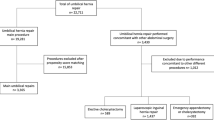Abstract
Background
Umbilical hernia is a common pathology and surgical repair is advised to prevent complications in symptomatic patients. However, risk factors that predict such advert events are unknown. The aim of the study was to determine whether morphological characteristics are associated with the occurrence of complications.
Method
Retrospective review of adult patients with elective and emergent umbilical hernia repair operated from January 2004 to December 2013. The size of the hernia and the size of the neck were measured based on operative reports, ultrasound, CT or MRI images. The Hernia–Neck-Ratio (HNR) was then calculated as novel risk indicator.
Results
106 patients underwent umbilical hernia repair (70 for uncomplicated and 36 for complicated hernia) as single procedure. The median size of the hernia sac was statistically significantly smaller in the uncomplicated group (30 mm, interquartile range (IQR) 20–49 vs. 50 mm, IQR 40–71, p = 0.037). The median size of the neck was not different between both groups (15 mm, IQR 11–29 vs. 16 mm, IQR 12–21, p = 0.44). The median HNR was smaller in the uncomplicated group (1.76, IQR 1.45–2.18 vs. 3.33, IQR 2.97–3.91, p = 0.00026). Based on ROC curve analysis (area under the curve: 0.9038), a cut-off value of 2.5 was associated with 91 % sensitivity and 84 % specificity.
Conclusions
A novel predictive factor for complications related to umbilical hernia is proposed. The Hernia–Neck Ratio can easily be calculated. These results suggest that umbilical hernia with HNR >2.5 should be operated, irrespective of the presence of symptoms.




Similar content being viewed by others
References
Poulose BK, Shelton J, Philips S et al (2012) Epidemiology and cost of ventral hernia repair: making the case for hernia research. Hernia 16:179
Nguyen M, Berger R, Hicks S (2014) Comparison of outcomes of synthetic mesh vs suture repair of elective primary ventral herniorrhaphy. A systematic review and meta-analysis. JAMA Surg 149(5):415–421
Helgstrand F, Rosenberg J, Kehlet H (2013) Outcomes after Emergency versus elective ventral hernia repair: a prospective nationwide study. World J Surg 37:2273–2279. doi:10.1007/s00268-013-2123-5
McKay A, Dixon E, Bathe O, Sutherland F (2009) Umbilical hernia repair in the presence of cirrhosis and ascites: result of a survey and review of the literature. Hernia 13:461–468
Carbonell A, Wolfe L, De Maria E (2005) Poor outcomes in cirrhosis-associated hernia repair: a nationwide cohort study of 32,033 patients. Hernia 9:353–357
Caglia P, Tracia A, Borzi L (2014) Incisional hernia in the elderly: risk factors and clinical considerations. Int J Surg 12:S164–S169
Rodriguez J, Hinder RA (2004) Surgical management of umbilical hernia. Oper Tech Gen Surg 6–3:156–164
Moher D, Hopewell S, Schulz K et al (2010) Consort 2010 Explanation and Elaboration; updated guidelines for reporting parallel group randomized trial. BMJ 340:c869
Dindo D, Demartines N, Clavien PA (2004) Classification of surgical complications. A new proposal with evaluation in a cohort of 6336 patients and results of a survey. Ann Surg 244:931–937
Dokmak S, Aussilhou B, Belghiti J (2012) Umbilical hernias and cirrhose. J Visc Surg 149:32–39
Marshman H, Heisterkamp J (2007) Management in patients with liver cirrhosis and an umbilical hernia. Surgery 142–143:372–375
Eker H, van Ramshorst GH, De Goede B (2011) A prospective study on elective umbilical hernia repair in patients with liver cirrhosis and ascites. Surgery 150–153:542–546
Belghiti J, Durand F (1997) Abdominal wall hernias in the setting of cirrhosis. Semin Liver Dis 17:3
Northup P, Wanamaker R, Lee V et al (2005) Model for End-Stage Liver Disease (MELD) predicts nontransplant surgical mortality in patients with cirrhosis. Ann Surg 242–2:244–251
Eker HH, van Ramshorst GH, de Goede B, Tilanus HW, Metselaar HJ, de Man RA, Lange JF, Kazemier G (2011) A prospective study on elective umbilical hernia repair in patients with liver cirrhosis and ascites. Surgery 150(3):542–546
Hassan AM, Salama AF, Hamdy H, Elsebae MM, Abdelaziz AM, Elzayat WA (2014) Outcome of sublay mesh repair in non-complicated umbilical hernia with liver cirrhosis and ascites. Int J Surg 12(2):181–185
Saleh F, Okrainec A, Cleary S, Jackson T (2015) Management of umbilical hernias in patients with ascites: development of a nomogram to predict mortality. Am J Surg 209–2:302–307
Fitzgibbons R, Giobbie-Hurder A, Gibbs J (2006) Watchful waiting vs repair of inguinal hernia in minimally symptomatic men. A randomized clinical trial. JAMA 295–3:285–292
Funding
None.
Author information
Authors and Affiliations
Corresponding author
Rights and permissions
About this article
Cite this article
Fueter, T., Schäfer, M., Fournier, P. et al. The Hernia–Neck-Ratio (HNR), a Novel Predictive Factor for Complications of Umbilical Hernia. World J Surg 40, 2084–2090 (2016). https://doi.org/10.1007/s00268-016-3556-4
Published:
Issue Date:
DOI: https://doi.org/10.1007/s00268-016-3556-4




